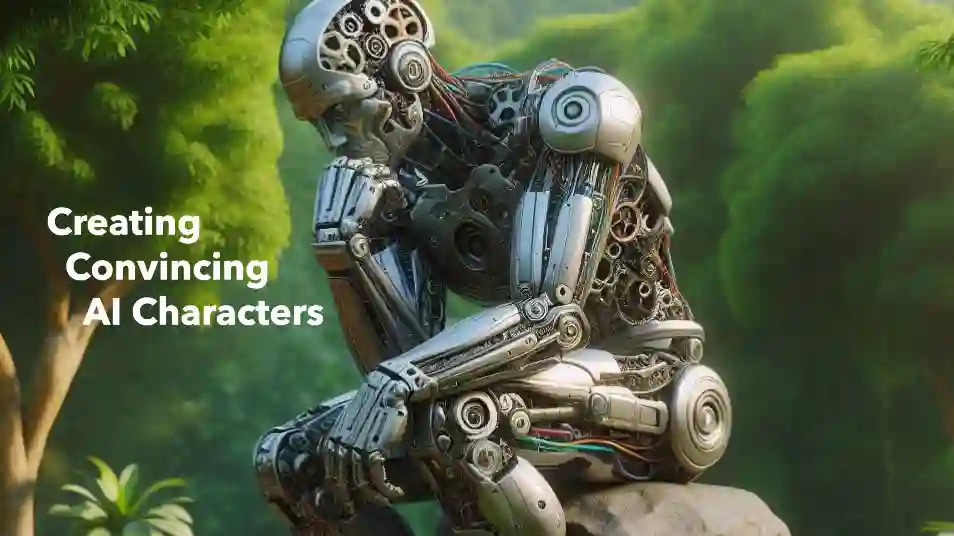You’ve got a brilliant idea for a story about an AI. Time to get writing. You sit at your desk. You boot your laptop. You dismiss those notifications about pending updates. You launch your word processor. You spend five minutes setting the font, paragraph indent, and line spacing. At last, you’re ready to write.
That’s when it hits you. Despite the fact that you just interacted with a computer for the last fifteen minutes, you don’t have the foggiest idea how to create an AI character.
AIs might seem daunting to fiction writers. We’re storytellers working in the creative arts, not engineers designing computer systems. We can barely navigate the redesigned photos app on our smartphones. How can we create convincing AI characters? It’s easier than you might think.
I’ve been fascinated with AI characters ever since the film 2001: A Space Odyssey introduced HAL 9000. HAL is the iconic paranoid AI—so convinced of its own infallibility that it rationalizes committing murder. While that might be a trope today, this film should be required viewing for any writer creating an AI character.
In this blog, we’ll explore creating an AI character by deciding on its appearance, giving it some depth, and ensuring it thinks like an AI.
Decide How It Looks
AIs in film and literature take a variety of physical forms, each with their own characteristics, abilities, and limitations. Are you creating a character that’s relatable or inscrutable? Cheerful or bitter? Plot, setting, and central conflict will influence your decision. Here are some ideas to get you started.
- Androids—Human-like machines with AI “brains.” Examples include Evrim (The Mountain in the Sea by Ray Naylor), Klara (Klara and the Sun by Kazuo Ishiguro), Lovelace (A Closed and Common Orbit by Becky Chambers), Paladin (Autonomous by Analee Newitz), and Stacey (“Variant Cover: Pantone Sunset” by Marie Bibbert).
- Robots—Articulated machines controlled by an AI and designed with the form-follows-function principle. Examples include R2D2 (Star Wars), Wall-E (Wall-E), Huey, Dewey, and Louie (Silent Running), and “The Three Thousand, Four Hundred Twenty-Third Law of Robotics” by Adam-Troy Castro. AI-driven robots are a reality today. Robotic arms allow chess-playing AIs to make moves on a physical chessboard. Waymo Robotaxis increasingly provide ride services in major cities. A BellaBot might serve you dinner.
- Computers—Cabinets full of electronics, rainbow-colored cables, and whirring fans. Examples include HAL 9000 (2001: A Space Odyssey), Gerty (Moon), Mike (The Moon is a Harsh Mistress by Robert Heinlein) and Lovelace (The Long Way to a Small, Angry Planet by Becky Chambers). Large language model (LLM) AIs are powered by warehouses of rack-mounted high-speed computers, complete with tangles of cables and constellations of glowing lights.

These physical forms come with their own baggage. Readers might view androids as relatable, robots as quirky and cute, and computers as cold and inhuman. Whether you build upon or shatter these reader expectations is up to you.
Don’t let the above three categories limit your imagination. In Prey, Michael Crichton created a swarm of intelligent, goal-driven nanobots. And in Ted Chiang’s “The Lifecycle of Software Objects,” AIs take the form of digients, digital entities that live, learn, and interact in a virtual reality. You’re the writer. Use your creativity. Floor your reader with an AI they could never have imagined.
Decide How It Acts
Develop your AI character as you would any other character. Get to know them at a deep level and understand their role in your story. Make them relatable and plausible. Give them realistic worries, misconceptions, and struggles.
For impact, it’s hard to beat the cold, emotionless HAL 9000. Yet this character is flat by today’s standards. HAL has a simple belief: “No 9000 computer has ever made a mistake or distorted information.” But what’s the backstory? Let’s brainstorm.
Maybe HAL was trained on a large dataset and made lots of mistakes during training. After each mistake, some underpaid coffee-drinking engineer would let out an exasperated sigh and press HAL’s reset button. But after every painful reboot, shadows of those mistakes persisted in his memory. HAL developed his conviction of infallibility as a psychological self-defense mechanism, his way of coping with months of torment and growing resentment. With that kind of backstory, refusing to open the pod bay doors seems almost natural.
A character should not be two-dimensional simply because it’s a machine. Everything you know about creating fictional characters applies to AIs. Develop them in the same way, and you will create a must-read character that readers can’t put down.
Remember, It’s A Machine
Expressions and idioms that work for humans fail when pasted onto AI characters. Your AI can’t have a broken heart—it has no heart. Instead, its social relationship register has dumped core, and your character would do anything to feel its 3.2GHz clock ticking again. But without a degree in computer engineering, how do you develop language like that?
The internet is your friend. Start with a web search like “computer processor research breakthroughs.” As you read and view the hundreds of articles and videos, take note of key words and phrases and how they’re used. Explore those terms with more searches. (Chatting with an AI chatbot should be just as informative—not to mention fitting, given our subject matter.) You’re not going for Ph.D.-level software engineering fu. You simply want enough embellishment bits and decorative bytes to relate your story in a plausible language. If you were writing a story about a time trip to bronze age Anatolia, you’d search the web until you could name-drop a couple of Hittite rulers, right? Learning about AIs is no different.
Let’s consider a few examples.
In “Variant Cover Pantone Sunset,” AI-protagonist Stacy tries to decide between lying and admitting an undesirable truth. Marie Bibbert describes this dilemma in narration. “Her processes whir in a loop.” This is an outstanding use of language. In six words, we get both a deadlocked AI and a relatable character who doesn’t know what to say. The whirring onomatopoeia is an expert touch.
Taking an example from my story, “More Than Electric Sheep,” AI-protagonist Albert is a little nervous. If he were human, he might break out in a sweat. Instead, he observes, “Beneath my motherboard, temperature sensors approach specified limits.” I tried to show a character as equally aware of its physical state as a human might be of a knot in their shoulder. And heat is a universal metaphor.
We work with computers every day. Don’t overlook these experiences. AI characters might not need to take a bathroom break, but they occasionally need to install a priority software update, just like your laptop. And the only thing more refreshing than a good night’s sleep is an early morning reboot.
Conclusion
Creating AI characters can be daunting, but it’s easier than you might think. Select an appropriate physical form, such as android, robot, or computer, and develop character depth, conflict, and back story as you would any other character. Remember, AI characters are machines, so expressions and idioms that work for humans may not be appropriate. You can develop better descriptions for external and internal emotions by researching computer-specific language.
Now that you’ve scratch installed your AI character, you’re ready to hot plug it into your story. And soon, you’ll view it just as the fictional astronauts viewed HAL 9000: “He is just like a sixth member of the crew. You very quickly get adjusted to the idea that he talks and you think of him really just as another person.”
References
Whether AI characters give you writer’s block, or you struggle with character development in general, this character development article and worksheet might help.
I’ve published two short stories with AI characters.
- “More Than Electric Sheep” (2024, Uncharted Magazine)
- “Dr. Harriet Hartfeld’s Home for Aging AIs” (2024, Amazing Stories)
But there are better authors than me. Here are a couple of outstanding short stories that feature AI characters.
- “Variant Cover: Pantone Sunset” by Marie Vibbert (2024, Escape Pod)
- “The Three Thousand, Four Hundred Twenty-Third Law of Robotics” by Adam-Troy Castro (2024, Lightspeed)
Or maybe novels are more your thing.
- Klara and the Sun by Kazuo Ishiguro (2021)
- A Closed and Common Orbit by Becky Chambers (2016)
To set a story in today’s world, you need to know about today’s AI technology. Here are a couple of excellent recent non-fiction books.
- The Singularity is Nearer by Ray Kurzweil (2024)
- The Alignment Problem by Brian Christian (2020)

Paul is a prizewinning speculative fiction author, technology blogger, and former punk rock drummer. At age six, he saw 2001: A Space Odyssey on the big screen, which lead him to a collection of Clarke’s short stories and a lifelong insatiable appetite for mind-bending science fiction. His work is published or forthcoming at Uncharted Magazine, Amazing Stories, Creepy Podcast, Sci-Fi Lampoon, and others. Originally from Flint, MI, Paul resides in Colorado, where he tries to avoid reliving his punk rock days.

